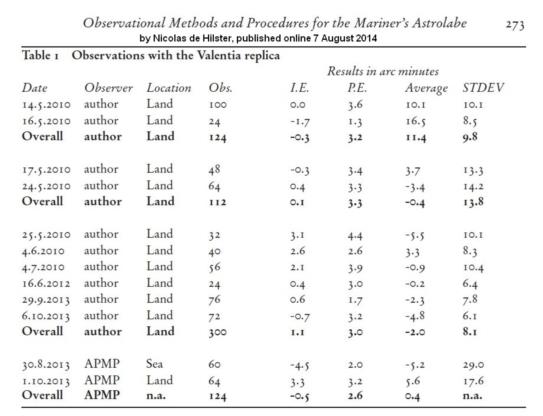
NavList:
A Community Devoted to the Preservation and Practice of Celestial Navigation and Other Methods of Traditional Wayfinding
From: Chuck Varney
Date: 2023 Nov 2, 11:13 -0700
For those with an interest in the mariner’s astrolable rather than the planispheric astrolabe, and particularly the use and observed accuracy of replicas of the Valentia astrolabe held by the Royal Museums Greenwich, see the following two accounts.
1) Robin Knox-Johnston used a mariner’s astrolabe to navigate an Atlantic crossing in the fall of 1989 from La Gomera Island to San Salvidor Island, emulating the 1492 sailing of Christopher Columbus. He wrote of this in The Columbus Venture, published in 1991. Based on his experience with the astrolabe on this trip, he authored a paper titled Practical Assessment of the Accuracy of the Astrolabe, which was published in the Mariner’s Mirror in 2013. It’s available here:
https://www.tandfonline.com/doi/full/10.1080/00253359.2013.766999
I have attached Knox-Johnston’s table of measurements, about which he wrote “. . . the average error in latitude, ignoring the reading on the thirteenth day, which any navigator would have mistrusted, recognizing that it might not be a very accurate reading at the time, is 13.63 nautical miles.” I put the astrolabe latitude errors observed on his 33-day passage into a spreadsheet to calculate the mean, mean absolute deviation (MAD), and Standard Deviation (SD) to see if I could confirm his statement. With the Day 13 outlier ( -88.2’ ) removed, I found the Mean, MAD and SD to be 0.2’, 13.6’, and 16.2’, respectively. The MAD result was close to 13.63’. When I simply took the average of the absolute values of his errors the result was 13.63’.
2) Nicolas de Hilster published a much more detailed account of his experience with 600+ measurements made with a Valentia replica in the Mariner’s Mirror in 2014. This link to his report, Observational Methods and Procedures for the Mariner's Astrolabe, appears to now require a payment of $50 US for full access:
https://www.tandfonline.com/doi/full/10.1080/00253359.2014.935141
The conclusion in the above-cited de Hilster paper was:
” Assessing the accuracy of the mariner’s astrolabe can only be done in a statistical manner using the same methods and instruments in use in early modern times. As the average is meaningless for the accuracy of the mariner’s astrolabe in general, it is of no importance how close the average reading to the expected altitude is. Only how far the observations are scattered around it counts, as this tells us more about the chance that the true altitude is really found using the methods of period navigators. The current research indicates that assessing the accuracy of the mariner’s astrolabe requires at least several hundred observations per observer over a prolonged period of time before we can say that the observer is fully fledged and even then another observer may achieve better results. When using an Iberian astrolabe on land an accuracy of 8 arc minutes is feasible for a reasonably experienced observer. Using the same astrolabe at sea depends on the observer, vessel and sea state, but 30 arc minutes can be achieved by an inexperienced observer. An analysis of period and modern data taken at sea shows that an 80 per cent agreement between observers within 20 arc minutes could be achieved and that an accuracy of 10 arc minutes is feasible. What has become clear above all is that in modern research more statistical data is needed, produced with more observers and properly made instruments of varying
diameters to get a full picture of the accuracy of the mariner’s astrolabe in general.”
I have attached the table of measurements from de Hilster’s report
Photos of the astroIabe that de Hilster used, along with some images from the above paper (Figures 9 - 13) are provided on his website here:
https://www.dehilster.info/navigational_instruments/1580s_mariners_astrolabe.php
Chuck V
Photos of the astrolabe that de Hilster used, along with some images from the above paper (Figures 9 – 13) are provided on his website here:








